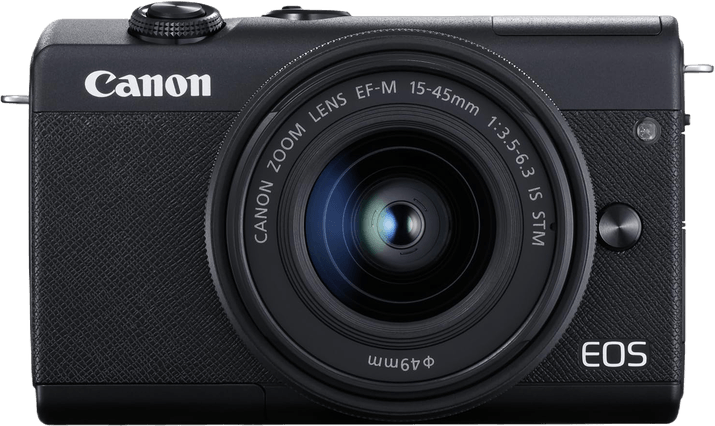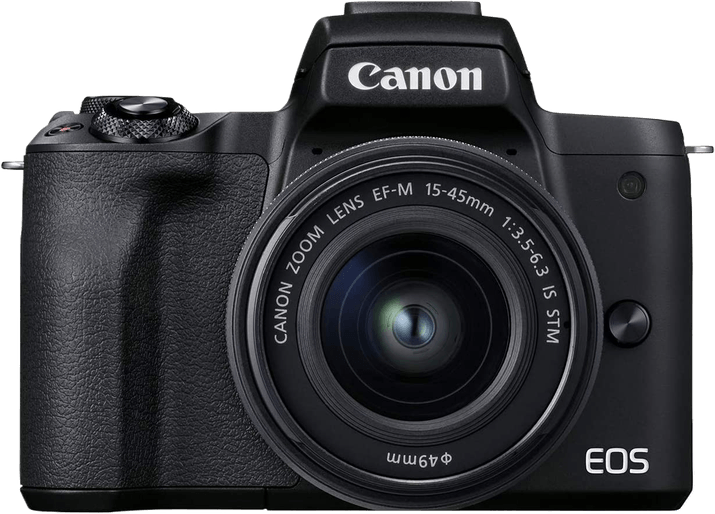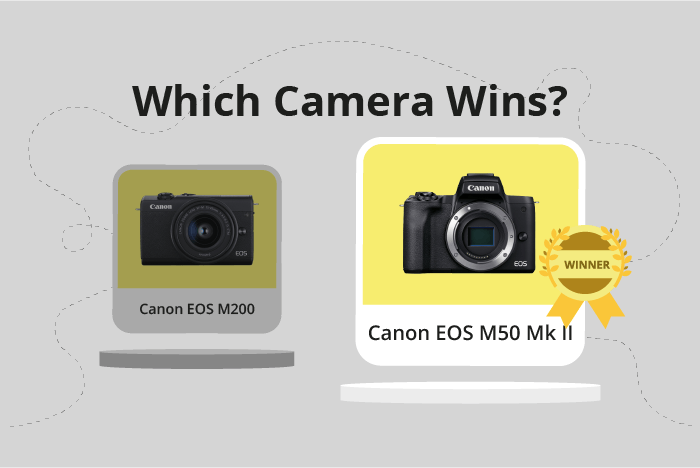Canon EOS M200 vs EOS M50 Mark II Comparison
Canon EOS M200

Canon EOS M50 Mark II

The Canon EOS M200 and Canon EOS M50 Mark II are both mirrorless cameras, released a year apart, with the M200 in 2019 and the M50 Mark II in 2020.
The EOS M50 Mark II has a slight advantage in size, measuring 116 x 88 x 59mm, compared to the M200’s 108 x 67 x 35mm. However, the M200 is lighter at 229g (0.50lbs) compared to the M50 Mark II’s 387g (0.85lbs), making it more portable.
Despite the size and weight differences, both cameras offer similar performance and quality. The choice between the two primarily depends on personal preference and budget. The M200 is more affordable and lightweight, while the M50 Mark II is slightly larger but offers the same quality.
Canon EOS M200 vs M50 Mark II Overview and Optics
The Canon EOS M200 wins in the optics comparison with a score of 62/100, a few points ahead of the Canon EOS M50. Both cameras share several specifications, such as having 24 megapixels, a CMOS sensor type, a Digic 8 processor, an APS-C sensor size, a Canon EF-M lens mount, and no image stabilization.
The M50 Mark II has a higher shooting speed of 10 frames per second, making it better for capturing fast-moving subjects and continuous shooting. This advantage allows photographers to take more shots in a shorter amount of time, increasing the chances of capturing the perfect moment.
On the other hand, the M200 has a slightly lower shooting speed of 6.1 frames per second. While it may not be as fast as the M50 Mark II, this speed is still adequate for casual photography and capturing everyday moments. The one-point difference in the optics score might not make a significant impact on the overall performance for some users, especially those who do not require a high shooting speed.
Both cameras have their strengths and weaknesses in terms of optics. The M50 Mark II is better for photographers who need a faster shooting speed, while the M200 is suitable for casual photography. The one-point difference in the optics score highlights that the cameras are quite similar, and users should consider their specific needs when deciding between the two models.
Canon EOS M200 vs M50 Mark II Video Performance
The Canon M50 Mark II outperforms the Canon M200 in video capabilities with a score of 91/100 compared to the M200’s 83/100. Both cameras share some common specifications, such as 4K maximum video resolution, 3840 x 2160 maximum video dimensions, and built-in time-lapse functionality. However, there are key differences that make the M50 Mark II the superior choice for video recording.
The main advantage of the M50 Mark II is its higher maximum video frame rate of 120fps, which is double the M200’s 60fps. This allows for smoother, more detailed slow-motion footage, providing greater creative flexibility for videographers. The higher frame rate is particularly beneficial for capturing fast-moving subjects or creating a more cinematic look in videos.
While the M200 does not offer any significant advantages over the M50 Mark II in terms of video capabilities, it still provides solid performance with its 4K resolution and time-lapse functionality. This makes the M200 a suitable option for casual video shooters or those on a tighter budget.
In comparing the video capabilities of the Canon EOS M200 and the Canon EOS M50 Mark II, the M50 Mark II emerges as the clear winner due to its higher frame rate. This advantage enhances the overall video quality and creative possibilities for users. Although the M200 does not surpass the M50 Mark II, it remains a viable option for those seeking a more budget-friendly camera with respectable video features.
Canon EOS M200 vs EOS M50 Mark II Features and Benefits
The Canon EOS M200 and Canon EOS M50 Mark II both score 70/100 in features, making them tied in this category. They share several specifications, including a 3-inch screen size, 1040000-dot screen resolution, touchscreen, flip screen, and the absence of GPS. Additionally, both cameras come with WIFI and Bluetooth connectivity.
The Canon EOS M50 Mark II excels in certain aspects. However, since the feature scores are tied, it does not surpass the M200 in any significant way. The M50 Mark II is a newer model, so it may have a slight edge in terms of updated technology, but this advantage is not reflected in the scores or specifications provided.
Similarly, the Canon EOS M200 does not hold any significant advantages over the M50 Mark II in terms of features. Both cameras share the same specifications, making it difficult to declare a clear winner. The M200 is an older model, but it still holds up well against its newer counterpart, the M50 Mark II.
Given the identical feature scores and shared specifications, selecting between the Canon EOS M200 and Canon EOS M50 Mark II comes down to personal preference and budget. Both cameras offer similar performance and capabilities, making either option suitable for various photography needs.
Canon EOS M200 vs EOS M50 Mark II Storage and Battery
The Canon EOS M200 and Canon EOS M50 Mark II both score 21/100 in storage and battery. These cameras share identical specifications in this aspect, with each offering a single memory card slot compatible with SD, SDHC, and SDXC (UHS-I compatible) cards. Both models also use the LP-E12 battery type and lack USB charging functionality.
The EOS M200 has a slightly longer battery life, providing 315 shots per charge compared to the M50 Mark II’s 305 shots. This 10-shot difference favors the M200 for extended shooting sessions. However, the M50 Mark II still performs reasonably well in terms of battery life.
Considering their storage and battery capabilities, both cameras showcase similar performance. The M200’s marginally better battery life may be advantageous for some users, while the M50 Mark II remains a reliable option. Ultimately, the choice between these two models should depend on other factors, such as general specifications, optics, video, and features.
Canon EOS M200 vs EOS M50 Mark II – Our Verdict
Are you still undecided about which camera is right for you? Have a look at these popular comparisons that feature the Canon EOS M200 or the Canon EOS M50 Mark II:

